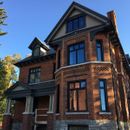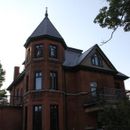Attic Insulation to Prevent Ice Damns
I’m looking to insulate the attic of a 1894 Victorian located in Pembroke, Ontario – Climate Zone 6. The soffits are unvented, they’re constructed of painted tongue and groove wood the gable ridges are vented and there is 1 x maxi vent on the flat roof, along with some venting around the perimeter of the flat roof. The turret roof area is unvented but connected to the main attic area by a gap of about 2′ by 1′. There is currently about 3-4″ of cellulose in the main attic space, and the rafters of the sloped ceiling of the third floor are filled with cellulose; however, over the years, that cellulose has settled. Three bathroom fans are vented to the outside via the flat roof. Naturally the property has ice damning issues in the winter especially in the valleys. I’m planning to update the insulation this summer and I’m looking for advice. I’m was also planning to insulate behind the kneewalls. One kneewall has an access panel, but it is fairly tight. The other kneewalls are in finished spaces. The house is a student rental, so one attic bedroom is vacant at the moment, so I was planning to insulate the kneewalls in this vacant bedroom and in the bathroom where the kneewall access panel is located. I’ve read the article here – https://www.finehomebuilding.com/2012/09/06/two-ways-to-insulate-attic-kneewalls. I’ve also read Martin’s response to comment #55 here – https://www.greenbuildingadvisor.com/article/lstibureks-rules-for-venting-roofs. I’d appreciate some recommendations given that I currently have ice damning issues. My original thoughts are to do 1.5″ of ccsf and cellulose in the attic to provide a total of R70 and top up the rafters of the sloped ceilings with cellulose. I’m not sure what approach I should take for the kneewalls yet.
Thanks in advance.
GBA Detail Library
A collection of one thousand construction details organized by climate and house part











Replies
Most of the time, ice dams are caused by air leaks. Adding R70 will not do much to prevent them unless you also air seal the place first.
With the complicated roof shape and rooms in the attic, you'll probably never be able to ice dam free unless you go with rigid insulation on the outside. Blower door assisted air sealing will go a long way in reducing them.